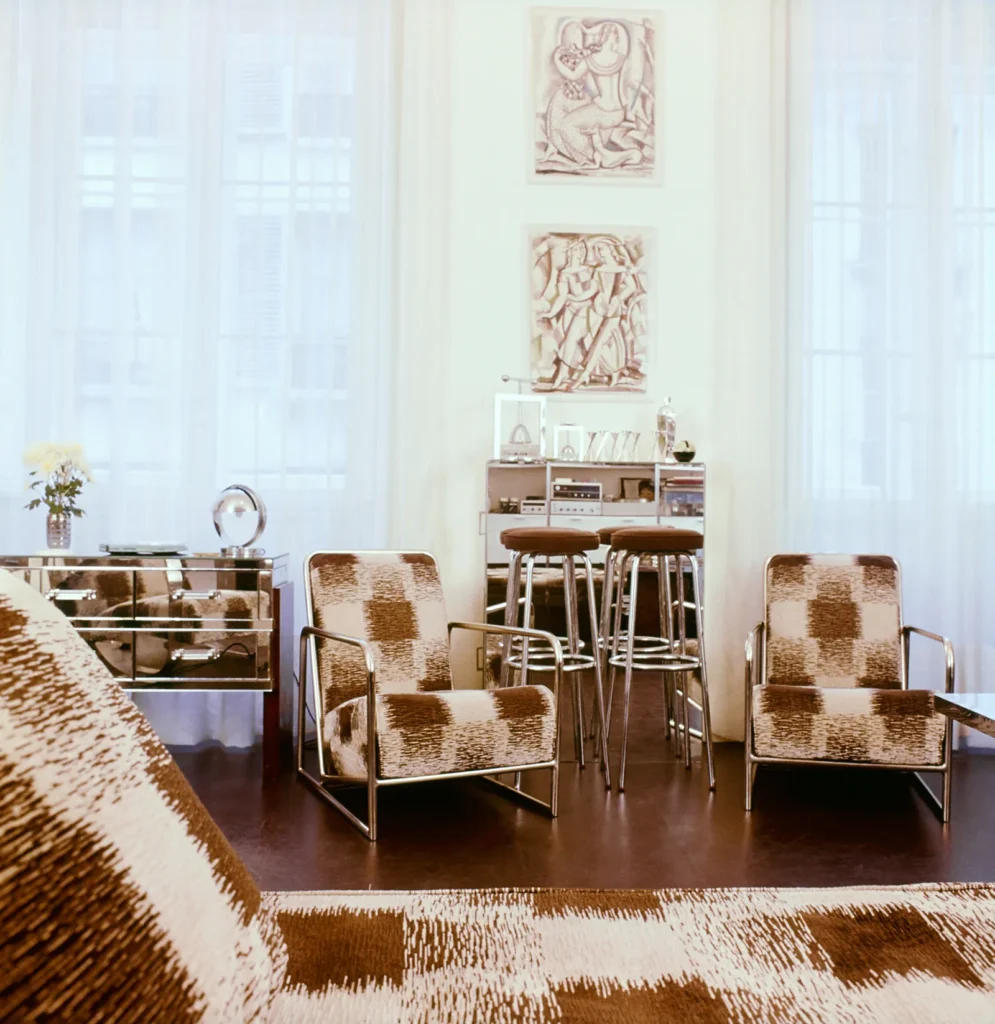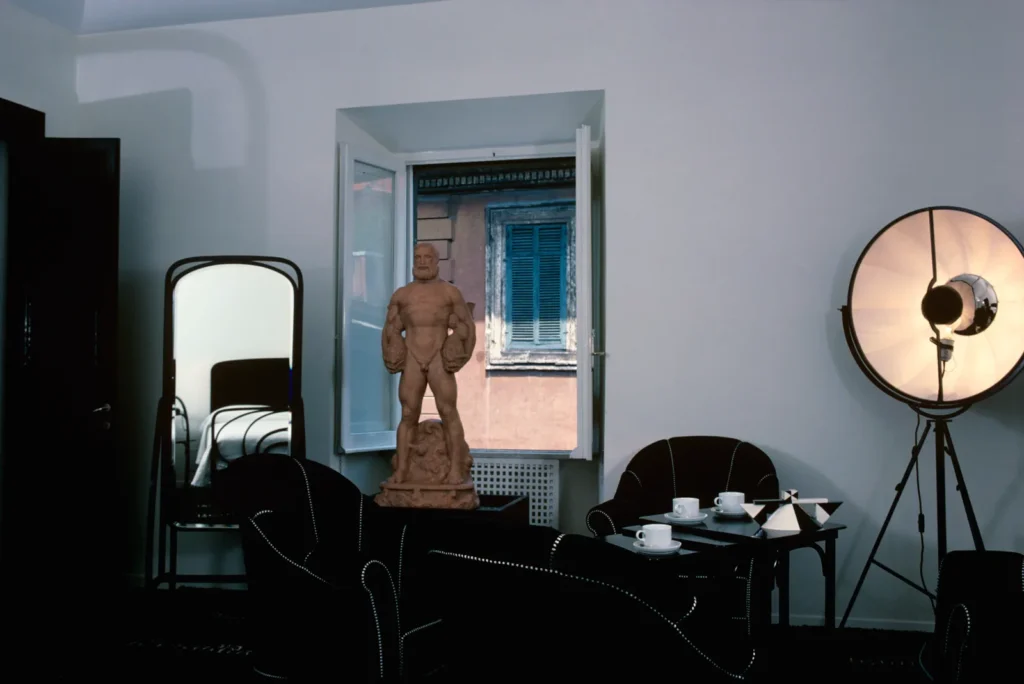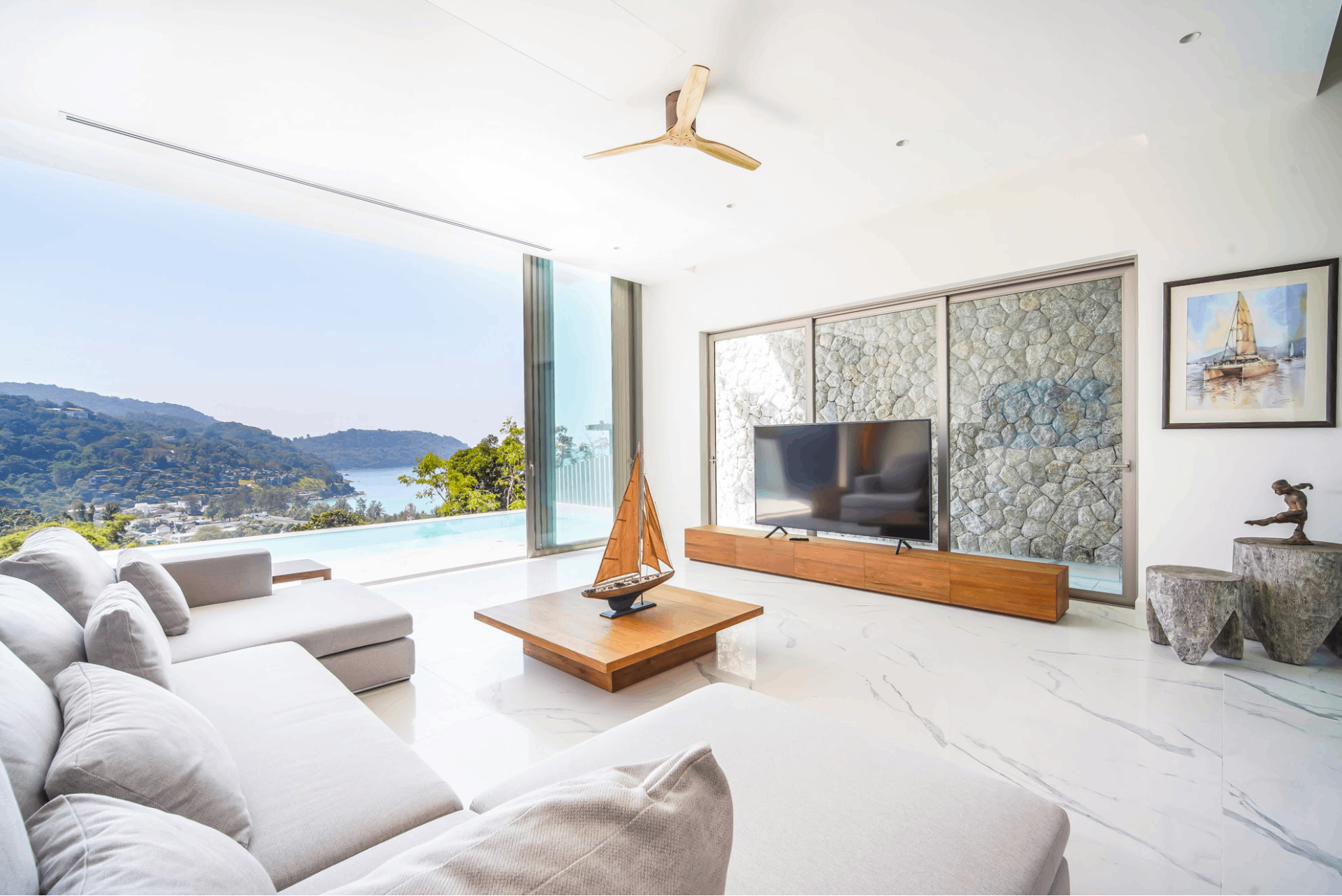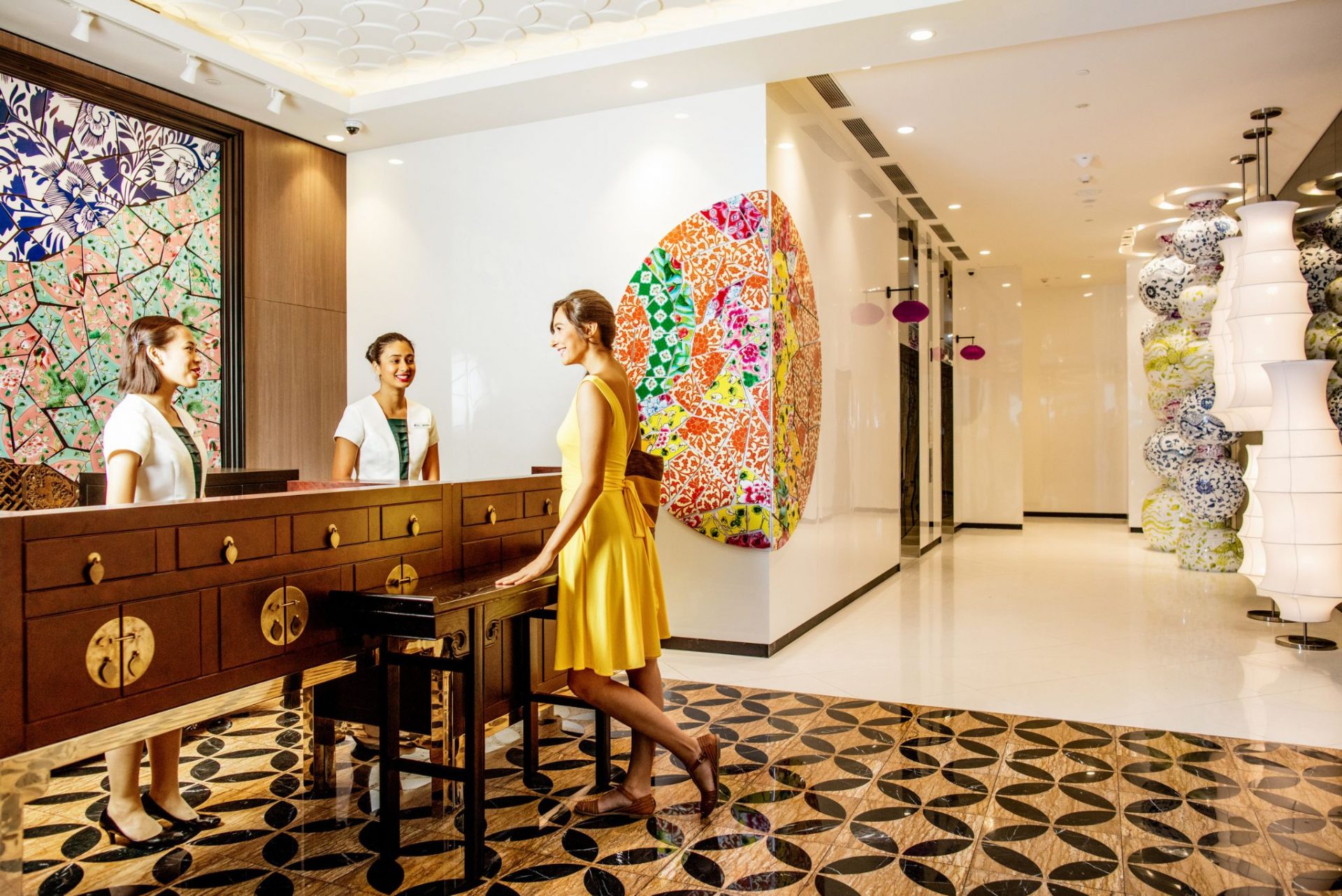In the grand tapestry of fashion, one name shines as a beacon of iconic style and innovation. Karl Lagerfeld, the genius behind some of the world’s most celebrated fashion houses, was not merely a designer but a true visionary. Beyond the confines of the runway, Lagerfeld was equally at home crafting opulent interiors as he was sketching elegant silhouettes. In this exclusive journey, we invite you to explore the hidden treasures of the fashion legend’s life—the extravagant homes he meticulously curated worldwide.
As we dive into the world of Karl Lagerfeld, we’ll discover a man of many talents. Not confined to the world of haute couture, Lagerfeld’s creative genius extended to interior design. In this arena, he displayed the same level of artistry and innovation that made him an icon in the fashion industry.
Our virtual tour will lead us to various corners of the globe, from Paris’s romantic streets to Monaco’s glitz and glamour, revealing Karl Lagerfeld’s penchant for the finer things in life. Each of his homes reflects his unique aesthetic, a captivating blend of luxury and minimalism, where each piece of art and every book were carefully chosen.
In the following pages, we will step inside his Parisian palace, explore his Hamburg haven, immerse ourselves in the chic atmosphere of Monaco, and bask in the serenity of his French countryside estates. Through this journey, we will unravel the man behind the enigmatic sunglasses, Lagerfeld, who was as much a design connoisseur as a fashion maestro.
We will delve into the recurring themes that bound his homes, such as luxury, meeting minimalism, and a deep-seated love for books and art. It’s a chance to appreciate the legacy he left in interior design, a legacy that mirrored his unique personality—extravagant, elegant, and deeply artistic.
Karl Lagerfeld’s name may forever be synonymous with the world of high fashion. Still, this article invites you to explore the other facets of his extraordinary life—the lavish homes that whispered tales of his impeccable taste and artistic spirit. Join us as we journey through the doors of Karl Lagerfeld’s extravagant homes. In this world, fashion meets interior design the most elegantly and extravagantly possible.
Karl Lagerfeld’s Extravagant Homes Around the World
The Multi-Talented Karl Lagerfeld

Karl Lagerfeld, more than a fashion icon, was a design polymath. Renowned for his extraordinary contributions to the fashion world, Lagerfeld’s creative prowess extended beyond couture collections. His talents encompassed various roles, from a celebrated fashion designer to a visionary interior decorator.
Lagerfeld was a stalwart in the ever-evolving fashion world, synonymous with innovation, elegance, and avant-garde style. As the creative director of iconic fashion houses, including Chanel and Fendi, he left an indelible mark on the industry, transforming these brands into global powerhouses. Lagerfeld’s ability to redefine and reinterpret classic designs made him a maverick in haute couture. He wasn’t merely a designer but a master of artistic reinvention.
Beyond the realm of fashion, Lagerfeld’s creative ambition knew no bounds. As we peel back the layers of his multi-faceted career, we find an artist who was equally at home in interior design. His approach to crafting captivating interiors paralleled his approach to fashion: extravagant, innovative, and effortlessly stylish.
Fashion Designer Extraordinaire
Karl Lagerfeld’s journey as a fashion designer began in the mid-20th century, characterized by fashion revolutions and societal changes. Lagerfeld’s designs mirrored the evolving times. His creative genius was first unveiled in the early 1960s when he joined the prestigious House of Tiziani in Rome. This marked the inception of a prolific career that would reshape fashion history.
As Lagerfeld moved on to become a key figure at the House of Chloé, he introduced a new era of ready-to-wear fashion. His creations for Chloé were fresh, light, and youthful, revolutionizing women’s fashion by making it more accessible and relatable. The Lagerfeld touch added a contemporary twist to classic styles.
However, Lagerfeld’s transformative stint at Chanel truly solidified his status as a fashion legend. He took the reins of the venerable French fashion house in 1983 when it was at risk of fading into obscurity. Lagerfeld breathed new life into the brand, reimagining Chanel’s iconic tweed suits and little black dresses. His audacious and avant-garde designs paid homage to Coco Chanel’s legacy while adding a modern twist, making Chanel more relevant than ever.
Interior Decorator Extraordinaire
While Lagerfeld’s influence in the fashion world is undeniable, his unique talents extended to another realm entirely—interior decoration. Just as he reshaped the fashion landscape, Lagerfeld applied his creative vision to the world of interiors, marking himself as a tastemaker in this field.
Lagerfeld’s approach to interior design was just as distinctive as his fashion philosophy. His homes embodied his aesthetic—opulent and minimalist, chic and timeless. A recurring theme in his interiors was the harmony between classic and contemporary design. He often adorned his residences with antique furnishings, art, and literature, creating a striking juxtaposition of old and new.
His passion for design wasn’t limited to his own space. Lagerfeld also undertook projects to redesign the interiors of prestigious hotels, including the iconic Hotel de Crillon in Paris. His vision extended to creating bespoke furniture pieces that showcased his commitment to meticulous craftsmanship.
The marriage of fashion and interior design in Lagerfeld’s work exemplified his innate ability to blend luxury with minimalism seamlessly. His homes were a testament to his unerring eye for detail and the art of curated aesthetics.
Karl Lagerfeld’s legacy as a multi-talented artist endures not just for his influence in fashion but also for his remarkable contributions to interior design. His capacity to transcend boundaries, reimagine the conventional, and leave an indelible mark on diverse creative fields is a testament to his extraordinary talent and vision. Lagerfeld’s impact on the design world, from the runway to the living room, is a legacy that continues to inspire and captivate.
A Legacy of Innovation

Innovation and a fearless embrace of the novel have defined Lagerfeld’s fashion and interior design legacy. His designs were forward-looking, pushing boundaries and challenging conventional norms. In fashion, he introduced bold, contemporary elements into timeless classics, creating collections that were both cutting-edge and timeless.
Likewise, his approach to interior decoration was characterized by an innate ability to breathe fresh life into spaces. Lagerfeld’s homes were a testament to the transformative power of design. He didn’t just decorate; he curated experiences. His meticulous attention to detail and the seamless integration of art, culture, and history into his interiors elevated them to high art.
A Glimpse into His World
Exploring Lagerfeld’s world was like stepping into an artistic masterpiece. His homes reflected his multifaceted personality, offering a glimpse into his intellectual depth, creative flair, and unapologetic extravagance.
In his Parisian abode, the city’s grandeur was mirrored in the opulent furnishings and eclectic artworks. Every piece was handpicked, and every space was meticulously orchestrated to convey a sense of timeless luxury.
His Hamburg residence, a mix of modernity and tradition, showcased his versatility. The city’s cosmopolitan vibe was met with a touch of old-world charm, resulting in a residence that seamlessly blended the past and the present.
Monaco, the epitome of chic sophistication, saw Lagerfeld’s home as an extension of the city’s glamour. The interiors were a captivating fusion of contemporary design and classic elegance, mirroring the man who called this city home.
The French countryside estates revealed Lagerfeld’s deep love for art and nature. Here, the interiors breathed life into the idyllic surroundings, making each residence a peaceful retreat and a sanctuary of serenity.
Karl Lagerfeld’s homes were a testament to his unique vision and unwavering commitment to artistic excellence. They were more than just living spaces; they were art galleries, libraries, and stages where his multifaceted creativity was displayed.
An Enduring Influence
The legacy of Karl Lagerfeld extends far beyond the realm of fashion. His extraordinary journey from designer to interior decorator is a testament to his boundless creativity. He challenged norms, shattered expectations, and forged a path many continue to admire and follow.
In fashion, his influence continues to be felt in every runway show, and in interior design, his distinctive aesthetic inspires decorators and homeowners. His vision was a link between two worlds, fusing the comfort of interior design with the elegance of fashion, all supported by his exceptional artistic sensibility.
Karl Lagerfeld’s career, spanning the worlds of fashion and interior design, reflects a remarkable journey of artistic exploration. He wasn’t merely a designer but a creator of experiences, leaving behind a legacy that continues to captivate and inspire the world. Lagerfeld’s homes were not just places to live; they were canvases where he painted his dreams, and they remain a testament to his enduring impact on the worlds of design and aesthetics.
Karl Lagerfeld’s Extravagant Homes Around the World
Karl Lagerfeld’s Homes: A Global Tour
Karl Lagerfeld, a name synonymous with creativity and innovation, was not confined to a single place, nor were his homes. Our journey through Lagerfeld’s extravagant residences worldwide promises nothing short of a globetrotting adventure. From Paris’s romanticism to Monaco’s glitz, we’ll take you on an immersive tour, unveiling the extravagance that defined his life.
The Parisian Grandeur
It’s impossible not to be enamored by Paris’ grandeur when we think of the city of love and romance. For Karl Lagerfeld, one of the fashion world’s most celebrated designers, Paris wasn’t just a city; it was a canvas on which he painted his unique vision. His Parisian home was a lavish masterpiece, reflecting his impeccable taste and creativity.
An Iconic Location
Lagerfeld’s Parisian residence was in one of the city’s most prestigious neighborhoods, a stone’s throw from landmarks like the Louvre and the Seine River. The location was a testament to Lagerfeld’s discerning eye for elegance and a reflection of his affinity for the city’s artistic heritage.
Timeless Elegance
Stepping into Lagerfeld’s Parisian abode was like entering a world of timeless elegance. The interiors were a careful blend of classic and contemporary design elements, resulting in a harmonious coexistence of history and modernity.
Opulence greeted visitors at every turn. The furnishings were adorned with sumptuous fabrics and intricate details, and the rooms were punctuated with statement pieces of artwork. It was clear that Lagerfeld’s love for art extended beyond the canvas and into every aspect of his life.
The Influence of Books and Art
One could only explore Lagerfeld’s home by noticing his profound love for books and art. Shelves lined with rare volumes and walls adorned with priceless artwork transformed his residence into a sanctuary of intellectual and artistic richness.
Books were not mere decorations but an integral part of Lagerfeld’s daily life. His vast collection included volumes on art, fashion, and literature, a testament to his insatiable curiosity and love for culture.
Art was not just for display; it was a way of life. Lagerfeld’s Parisian home was an art gallery in its own right. Paintings, sculptures, and collectibles were thoughtfully curated to create a unique blend of extravagance and intellectual stimulation.
Harmonious Coexistence

What truly set Lagerfeld’s Parisian home apart was the harmonious coexistence of elements that might seem contradictory in lesser hands. The blend of classical luxury with modern aesthetics was his signature. The result was a residence that offered a sense of nostalgia while remaining unmistakably contemporary.
His home was a reflection of a life that transcended the ordinary. Lagerfeld’s ability to create simultaneously sumptuous and comfortable interiors, classic and contemporary, was nothing short of extraordinary.
Karl Lagerfeld’s Parisian home was not just a residence but an embodiment of his multifaceted personality. The city’s grandeur was mirrored in the lavish furnishings and eclectic artworks. At the same time, the influence of books and art provided an intellectual depth that is the hallmark of a true tastemaker.
As we leave the opulent Parisian residence behind, we deeply appreciate Lagerfeld’s unique vision and the enduring legacy he left in interior design. Paris, the city of love and art, was the perfect canvas for Lagerfeld to craft his unique masterpiece, and his home remains a testament to the artistic brilliance of the man who forever changed the way we see the world of design.
A German Haven
Amid the vibrant tapestry of the fashion world, Karl Lagerfeld’s life was punctuated by his wanderlust and profound connection with the places he called home. Our journey through Lagerfeld’s homes takes us to a unique blend of modernity and tradition, his Hamburg residence. This German haven reflected the designer’s multifaceted personality, showcasing a profound connection to his homeland and modern design vision.
A Homecoming of Sorts
Hamburg, Germany, was not just a location for Lagerfeld’s residence but a return to his roots. Born in the nearby city of Hamburg, he maintained a deep connection with this city throughout his life. Lagerfeld’s Hamburg home was not merely a house; it was a haven where the past met the present.
A Blend of Modernity and Tradition
The seamless fusion of tradition and modernity strikes us as soon as we enter Lagerfeld’s Hamburg home. The city’s cosmopolitan vibes were effortlessly integrated with a touch of old-world charm, creating an environment that felt both cutting-edge and steeped in history.
Lagerfeld’s innate ability to merge the past with the present was showcased here. Vintage elements were thoughtfully incorporated into contemporary design, resulting in a residence offering nostalgia while unmistakably modern.
A Living Gallery
Lagerfeld’s love for art was not confined to his fashion creations. His Hamburg residence was a living gallery where his passion for art came to life. The interiors were adorned with sculptures, paintings, and artistic elements that transcended mere decoration. They were an integral part of Lagerfeld’s daily life, a testament to his unwavering appreciation for artistic expression.
It was not just about art for the sake of art but about art as a way of life. The sculptures and paintings were not just displays but companions, each with its own story and significance in Lagerfeld’s world.
A Life Well Curated
Lagerfeld’s Hamburg residence was a reflection of a life well-curated. Every piece of furniture, every artwork, and every element of design was carefully selected to contribute to the overall narrative of the space. It was a home where attention to detail was palpable, and each element seemed to have a purpose.
The residence was a testament to Lagerfeld’s unique talent for seamlessly blending elements that might seem contradictory in lesser hands. The old and the new, the classic and the contemporary—they all harmonized, creating a comforting and cutting-edge home.
As we leave behind Lagerfeld’s Hamburg residence, we carry with us a sense of the man’s deep connection to his roots and an appreciation for his unique design vision. Hamburg, a city that straddles tradition and modernity, was the perfect backdrop for Lagerfeld’s residence, and his home remains a testament to the artistic brilliance of a man who forever changed the way we see the world of design. It’s a blend of modernity and tradition that truly reflects Lagerfeld’s multifaceted personality. This haven speaks to the enduring allure of blending the past with the present.
A Chic Slice of Monaco
Monaco, the playground of the rich and famous, is synonymous with luxury, style, and glamour. For Karl Lagerfeld, one of the world’s most celebrated fashion designers, Monaco was not just a destination; it embodied his refined tastes and the epitome of elegance. Our next stop on the journey through Lagerfeld’s extravagant residences takes us to the city-state of Monaco, where we unveil his stylish abode.
The Epitome of Chic
Monaco, a city known for its chic sophistication and luxury, was the perfect backdrop for Lagerfeld’s home. His residence here extended the city’s reputation for glamour and elegance.
The interiors of Lagerfeld’s Monaco home immediately strike us as being grand. The living spaces are a captivating fusion of contemporary design and classic elegance, a true reflection of the man who called this city home.
Contemporary Luxury
Every room in Lagerfeld’s Monaco residence exudes contemporary luxury. The interiors were a masterclass in modern aesthetics, from sleek furnishings to cutting-edge design elements. This home spoke to the present, a testament to Lagerfeld’s unwavering commitment to staying ahead of the curve.
The entire residence was designed with meticulous attention to detail. Every piece of furniture, every work of art, and every decorative element were carefully selected to create a space that was not just stylish but also inviting and comfortable.
A Symphony of Opulence

Monaco’s reputation for extravagance was met with Lagerfeld’s unique style. The result was a residence that exuded a sense of grandeur at every turn. Gold accents, luxurious fabrics, and statement pieces of artwork adorned the interiors, creating a living space that was truly fit for a fashion icon.
It was clear that Lagerfeld’s Monaco home was more than just a place of residence; it was an extension of his artistic expression. Every corner reflected his love for design and his passion for elegance.
The Elegance of Monaco in Every Room
As we explore Lagerfeld’s Monaco residence, we discover that every room was thoughtfully curated to capture the essence of Monaco’s elegance. The city’s unique charm and allure were seamlessly integrated into every aspect of the interiors.
From the breathtaking views of the Mediterranean Sea to the timeless design elements, Lagerfeld’s Monaco residence was not just a stylish abode but a living testament to the city’s spirit.
As we leave Lagerfeld’s chic Monaco residence behind, we are left with a profound appreciation for the man’s unique vision and the enduring legacy he left in the world of interior design. Monaco, the city of style and luxury, was the perfect backdrop for Lagerfeld’s stylish abode, and his home remains a testament to the artistic brilliance of a man who forever changed the way we see the world of design.
It was a chic slice of Monaco, a space where contemporary luxury met timeless elegance, and it continues to inspire decorators and homeowners with its unique blend of extravagance and style. Lagerfeld’s Monaco residence is a living masterpiece that reflects his multifaceted personality and embodies his vision of chic sophistication.
The Enchanting Estates in the French Countryside
Venturing beyond the bustling fashion capitals and into the serene embrace of the French countryside, we uncover a different facet of Karl Lagerfeld’s extraordinary life. His love for art and nature, two passions that defined his existence, found their perfect expression in his charming French countryside homes. As we journey through these estates, we discover the man behind the enigmatic sunglasses and his profound connection with the natural world.
An Idyllic Retreat
Lagerfeld’s French countryside estates were a world away from the fast-paced fashion industry. Nestled in the heart of rural France, these homes were idyllic retreats, places where the designer could seek solace, inspiration, and the beauty of nature.
The interiors of these estates reflected Lagerfeld’s commitment to harmony with the natural surroundings. The homes were designed to seamlessly blend with the picturesque landscapes, creating an atmosphere of tranquility that starkly contrasted with the chaos of the fashion world.
Art Meets Nature
Lagerfeld’s love for art was not confined to museums and galleries. His estates served as a canvas for his artistic vision, where the lines between art and nature blurred. Scattered throughout the properties were sculptures, paintings, and artistic elements that seemed organically grown alongside the trees and flowers.
The gardens themselves were a work of art, meticulously landscaped to create an environment that was beautiful and served as a sanctuary for artistic inspiration. Lagerfeld saw his French countryside estates as living art installations where every element was a piece of a larger masterpiece.
A Sanctuary of Serenity
In the French countryside, the rustic charm was met with the sophistication of Lagerfeld’s design sensibility. The interiors were a blend of vintage charm and contemporary comfort, creating spaces that were not just inviting but also stylish.
Every room in these estates seemed to reflect the natural surroundings. Large windows opened up to stunning vistas of rolling hills and pristine lakes. The rustic elements, such as exposed wooden beams and stone fireplaces, were seamlessly integrated with modern furnishings, creating a cozy and elegant atmosphere.
An Unveiling of Lagerfeld’s Soul
Lagerfeld’s French countryside homes were more than residences; they were a window into his soul. Here, the fashion icon who had redefined style on the runway found solace in the simplicity of rural life.
The estates were not just places to escape the world; they were reflections of Lagerfeld’s innermost passions. They showcased his deep love for art and nature and remain a testament to the man who had a profound impact not just in fashion but also in the world of design and aesthetics.
As we conclude our journey through Lagerfeld’s charming French countryside homes, we are left with a deep appreciation for the man who seamlessly merged the worlds of fashion and interior design. These estates are not just places to live; they are works of art, living testaments to the artistic brilliance of a man who forever changed how we see the design world.
Lagerfeld’s French countryside homes embody his love for art and nature, a sanctuary of serenity, and a reflection of his multifaceted personality. They remain a source of inspiration for decorators and homeowners, reminding us that the world of design is not confined to the city but can be found in the enchanting embrace of nature.
The Lagerfeld Aesthetic
As we journey through the opulent residences of Karl Lagerfeld, a captivating revelation emerges—the Lagerfeld aesthetic. This unique aesthetic is the thread that ties his diverse homes worldwide together. From Paris to the French countryside, common elements define Lagerfeld’s approach to design. This exploration delves into the Lagerfeld Aesthetic, uncovering the recurrent themes that tie his homes together.
Opulence Meets Minimalism: Karl Lagerfeld’s Unique Design Blend
Karl Lagerfeld, a name synonymous with creativity and innovation, was not just a fashion designer but a true master of design in its broadest sense. One of the most striking aspects of his design approach is the harmonious coexistence of luxury and minimalism, a delicate dance that defines the Lagerfeld Aesthetic. Lagerfeld’s ability to blend luxurious and minimalist design elements is a testament to his multifaceted creativity and his unique vision of the world.
The Marriage of Luxurious and Minimalist Elements
One of the defining characteristics of Lagerfeld’s design approach is his ability to bring together seemingly contradictory elements. On the one hand, his interiors stand out for their opulent features like plush furnishings, gilded accents, and luxurious fabrics. These elements exude a sense of grandeur and luxury that is unmistakable.
On the other hand, Lagerfeld incorporates minimalist design principles with precision. His spaces are uncluttered, and every element serves a purpose. Excess is replaced with a sense of order and simplicity. The result is a lavish and understated environment, creating a unique and captivating atmosphere.
The Power of Precision
Lagerfeld’s approach to design is rooted in precision. Whether wealthy or minimalist, every piece is carefully selected to contribute to the overall narrative of the space. Nothing is arbitrary; every element has its place and purpose. This level of precision is a testament to Lagerfeld’s commitment to creating living spaces that are not just beautiful but also functional.
The marriage of luxury and minimalism is not haphazard; it results from meticulous planning and an acute understanding of how each element contributes to the whole. It’s a fine balance that Lagerfeld mastered, and it’s one of the reasons why his interiors are so captivating.
Creating Atmospheres with Purpose
Lagerfeld’s ability to blend luxury and minimalism is not just about aesthetics; it’s also about creating spaces with a specific purpose. His interiors are not just for show; they are designed for living. The minimalist elements create an uncluttered and functional environment, while the abundant details add a sense of luxury and comfort.
Whether it’s a living room, a bedroom, or a dining space, Lagerfeld’s interiors are thoughtfully curated to serve their intended purpose. The result is not just a space that looks good; it’s a space that feels good and is a pleasure to live in.
A Timeless Elegance

Above all, Lagerfeld’s blend of luxury and minimalism exudes a sense of timeless elegance. His design decisions are based on enduring beauty and sophistication rather than passing trends. Lagerfeld’s interiors are built to withstand the test of time, making them as relevant and captivating today as they were when they were first designed.
Combining luxurious and minimalist design elements creates a balance that transcends fashion and trends. It’s a statement of enduring style and a testament to Lagerfeld’s exceptional design sensibility.
Karl Lagerfeld’s ability to blend luxury with minimalism is a testament to his multifaceted creativity and profound understanding of design. His interiors are not just about aesthetics; they are about creating beautiful and functional environments. The delicate dance between lavish and understated elements reflects Lagerfeld’s commitment to precision and his unique vision of the world.
The Lagerfeld Aesthetic is not just a style; it’s a statement of enduring elegance that continues to inspire and captivate. Lagerfeld’s ability to harmoniously blend opulence and minimalism is a true reflection of his genius in design.
His Love for Books and Art: Lagerfeld’s Passion Reflected in His Homes
Karl Lagerfeld, an icon in the fashion world, was not only a visionary in the realm of design but also a genuine lover of books and art. His homes were not mere spaces of residence; they were reflections of his profound passion for literature and artistic expression. As we explore Lagerfeld’s homes, we discover the deep-seated influence of books and art in every corner, turning these living spaces into sanctuaries of intellectual and artistic richness.
A Haven for Literature
One of the most striking aspects of Lagerfeld’s homes is the sheer volume of books that filled every room. Shelves lined with rare volumes on topics ranging from fashion to history to literature were not just decorative but an integral part of his daily life. Lagerfeld’s vast collection of books was a testament to his insatiable curiosity and love for culture.
Lagerfeld was known for his voracious appetite for reading, and his homes were knowledge repositories. These books were not just for show; they were meant to be read and enjoyed. The presence of literature was not just a decoration but an invitation to explore the world of ideas, reflecting Lagerfeld’s deep love for intellectual enrichment.
Art as a Way of Life
Art was not confined to galleries and museums in Lagerfeld’s world; it was an integral part of his living spaces. His homes served as living galleries where artistic expression thrived. Paintings, sculptures, and collectibles were thoughtfully curated, creating an environment where art was appreciated and celebrated.
Each piece of art had its own story and significance in Lagerfeld’s world. He was not just a collector but a true admirer of art. These artistic elements were not mere decor but companions that reflected his profound love for artistic expression.
A Blend of Culture and Style
Lagerfeld’s love for books and art was not confined to individual pieces but was also reflected in the overall design of his homes. The interiors bore the fusion of culture and style. Whether classical or contemporary, the artwork was harmoniously integrated into the decor, becoming an inseparable part of the living spaces.
His homes were designed for visual appeal and intellectual and artistic stimulation. Every room was a reflection of his impeccable taste and his multifaceted personality. The presence of books and art was a testament to Lagerfeld’s commitment to creating environments that celebrated culture, history, and the arts.
A Living Testament to Passion
We find a living testament to his passion for books and art in every corner of Lagerfeld’s homes. The books and artwork were not just for personal enjoyment but were meant to inspire and evoke thought. These elements reflected a man who influenced the fashion world and left an indelible mark on the world of design and aesthetics.
Homes for Lagerfeld were more than just places to live; they were also settings for inspiration and the intellectual and artistic richness that characterized his life. His love for books and art was not a hobby but a way of life, and his homes stand as a testament to the depth of his passions.
As we explore Lagerfeld’s homes and delve into his love for books and art, we are left with a profound appreciation for the man behind the iconic sunglasses. His homes were not just showcases of design; they were sanctuaries of intellectual and artistic richness. Lagerfeld’s passion for literature and art was not confined to his professional life but was woven into the very fabric of his existence.
His homes were not just reflections of his impeccable taste but also an embodiment of his multifaceted personality. Lagerfeld’s love for books and art continues to inspire and captivate, serving as a reminder that the design world is not just about aesthetics but also intellectual and artistic enrichment.
Karl Lagerfeld’s Legacy: A Reflection on His Impact on Fashion and Interior Design
Karl Lagerfeld, a name synonymous with creativity and innovation, left an indelible mark not just in the world of fashion but also in the realm of interior design. As we reflect on his enduring legacy, we discover his profound impact on these two distinct yet interconnected worlds. Lagerfeld’s legacy is not just about style; it’s about redefining how we perceive and experience design.
A Fashion Icon
Pure talent, unrestricted creativity, and an unwavering commitment to pushing boundaries were hallmarks of Karl Lagerfeld’s journey to becoming a fashion icon. His early work with fashion houses like Fendi and Chanel catapulted him into the limelight. Lagerfeld’s designs were not just about clothing but about creating an entire lifestyle.
His impact on the fashion industry was revolutionary. Lagerfeld was known for infusing new life into established fashion houses, reimagining their image, and breathing fresh energy into their collections. His ability to balance tradition with innovation was a testament to his unique design sensibility.
His capacity to transcend time and trends is what will define Lagerfeld’s fashion legacy. His designs continue to be celebrated today, and his influence can be seen in the work of countless designers who followed in his footsteps. His impact on the fashion world is immeasurable, and it continues to inspire and captivate.
A Visionary in Interior Design
Lagerfeld’s foray into interior design was not a departure from fashion but an extension of his creative vision. His homes served as blank canvases where he could translate his love for art, culture, and aesthetics into tangible spaces. Lagerfeld’s approach to interior design was marked by a unique blend of luxury and minimalism, a delicate dance that defined the Lagerfeld Aesthetic.
His ability to harmoniously blend these seemingly contradictory elements set him apart in interior design. His homes were not just for show; they were spaces for living. Lagerfeld’s interiors were thoughtfully curated to serve their intended purpose, and this level of precision was a reflection of his commitment to creating living spaces that were both beautiful and functional.
Transcending Boundaries
Karl Lagerfeld’s legacy goes beyond the realms of fashion and interior design. He was a visionary who transcended boundaries, challenging the status quo and redefining how we perceive and experience design. His influence can be seen not just in the world of high fashion but also in everyday aesthetics.
Lagerfeld’s ability to seamlessly blend opulence with minimalism, his love for books and art, and his timeless elegance serve as an enduring source of inspiration for designers and decorators alike. His legacy is a reminder that design is not confined to a single discipline but is a universal language of creativity and style.
A Lasting Impact
As we reflect on Karl Lagerfeld’s legacy, we are left with a deep appreciation for the man who forever changed how we see fashion and interior design. His impact is not confined to a particular era; it is timeless and enduring. Lagerfeld’s ability to create beauty and elegance in every aspect of life is a legacy that continues to inspire and captivate, reminding us that the world of design is a reflection of the human spirit’s boundless creativity.
A Visionary Beyond His Time
Karl Lagerfeld’s impact on the worlds of fashion and interior design transcends the temporal boundaries of his lifetime. He was a visionary whose innovative approach continues to influence and guide the creative minds of today and tomorrow.
In fashion, Lagerfeld’s legacy is felt in every meticulously designed piece, in the way collections are presented, and in the attitude of fashion houses towards constant evolution. He showed the world that fashion is not just about clothing but an intricate tapestry of art, culture, and self-expression. His distinctive style, which includes his recognizable fingerless gloves, high collars, and dark sunglasses, has irrevocably changed the industry. His creative spirit encourages designers to push beyond the ordinary, to take risks, and to see fashion as a living, breathing art form.
Lagerfeld’s influence on interior design is equally profound. His ability to blend the extravagant with the minimal and create opulent and functional spaces remains a source of inspiration. His precise attention to detail, his ability to curate collections that reflect his multifaceted personality, and his timeless elegance are lessons that continue to guide the world of interior design. His legacy reminds us that our living spaces are not just places for habitation but extensions of our individuality and artistic expression.
An Artist and a Collector
Karl Lagerfeld was not just a fashion and interior designer but also an artist and collector. His passion for literature, as reflected in his extensive collection of books, and his love for art, manifested in his carefully curated artworks, demonstrate his dedication to intellectual and artistic pursuits.
His homes were more than just places of residence; they were living galleries where each piece of art and each book was an integral part of the larger masterpiece. Lagerfeld’s approach to books and art was not one of ownership but of appreciation. He recognized the power of these elements to inspire and stimulate, and his homes were testaments to his multifaceted passions.
As a collector, Lagerfeld taught us the importance of surrounding ourselves with meaningful and significant objects. His legacy encourages us to be more intentional about our choices, to seek out items that resonate with our individuality, and to appreciate the intellectual and artistic richness they bring to our lives.
The Enduring Influence
Karl Lagerfeld’s legacy is not confined to a particular place or time; it is a universal language of creativity and style. His ability to seamlessly blend elements that might seem contradictory in lesser hands, his capacity to create beauty and elegance in every aspect of life, and his visionary approach to design continue to inspire designers, artists, and individuals from all walks of life.
His legacy is not just about fashion and interior design; it’s about pushing the boundaries of creativity, embracing the human spirit’s multifaceted nature, and redefining how we perceive and experience design in all its forms. Karl Lagerfeld’s enduring influence reminds us that design is not static but ever-evolving and reflects the human spirit’s boundless creativity.
A Living Testament to Excellence
Karl Lagerfeld’s life and work are a living testament to the pursuit of excellence. His commitment to pushing the boundaries of design and his unrelenting passion for creativity are values that continue to inspire and guide those in the fields of fashion and interior design.
In fashion, Lagerfeld’s legacy is a reminder that true innovation is born from a marriage of tradition and experimentation. He showed the world that respecting the heritage of fashion houses while daring to be bold in design is the key to ongoing relevance. His creative spirit encourages designers to never settle for the ordinary, to embrace change, and to see fashion as a dynamic and ever-evolving art form.
In interior design, Lagerfeld’s legacy underscores the importance of attention to detail, the curation of spaces that reflect one’s identity, and the creation of beautiful and functional environments. His timeless elegance guides those who understand that design is not merely about aesthetics but about enriching the human experience.
Karl Lagerfeld’s Enduring Relevance
The enduring relevance of Karl Lagerfeld’s legacy lies in the fact that he was not content to rest on his laurels. He was a creator, a visionary, and an artist until the end. His work continues to influence contemporary designers and homeowners who look to his multifaceted approach as inspiration.
Lagerfeld’s unique blend of luxury and minimalism, how he celebrated the power of literature and art, and his ability to merge classic and contemporary design elements seamlessly are pertinent lessons. His approach to fashion and interior design is timeless and unaffected by fads or trends; it inspires those who value creativity and artistry.
As we celebrate Karl Lagerfeld’s enduring legacy, we are reminded that design, whether in fashion or interior spaces, is a dynamic and ever-evolving art form. Lagerfeld’s work encourages us to be bold and innovative and to recognize that true excellence is in pursuing one’s creative passions.
A Lasting Tribute
Karl Lagerfeld’s legacy is not a static monument but a living tribute to the power of creativity, style, and design. It is a reminder that design is not merely about the arrangement of elements in space but about the arrangement of ideas, experiences, and emotions. Lagerfeld’s work lives on, not just in the collections and homes he designed but in the hearts and minds of those who continue to be inspired by his unique vision.
His legacy encourages us to see the world through the lens of endless possibilities, to embrace the union of luxury and minimalism, to recognize the value of intellectual and artistic enrichment, and to understand that design is a reflection of our multifaceted selves. Karl Lagerfeld’s enduring influence extends far beyond fashion and interior design; it is a legacy of creativity, innovation, and a commitment to excellence that will continue to inspire future generations.
In the design world, Karl Lagerfeld was not just a name; he was a visionary, a creative genius who left an indelible mark on fashion and interior design. His extravagant homes, as diverse as they were, served as living testaments to his multifaceted creativity and his profound understanding of the power of aesthetics. As we conclude our journey through the opulent residences of Karl Lagerfeld, we reflect on their significance in the design world.
Karl Lagerfeld’s homes were not just places to live but spaces to be inspired. As we’ve discovered, the Lagerfeld Aesthetic is a universal language of style. It seamlessly blends luxury with minimalism, celebrates the power of literature and art, and fuses the classic with the contemporary. Lagerfeld’s design philosophy goes beyond time and trends, reminding us that true design is enduring.
His homes served as a reminder that design is not just about aesthetics but about the marriage of functionality and beauty. His ability to create environments that are both beautiful and functional is a lesson that continues to guide contemporary designers and homeowners.
Karl Lagerfeld’s extravagant homes continue to inspire and captivate, serving as a reminder that design is not a static concept but a dynamic and ever-evolving art form. His timeless elegance, a blend of classic and contemporary elements, and harmonious marriage of luxury and minimalism are enduring sources of inspiration for those who value creativity and artistry.
Lagerfeld’s influence is not confined to a particular period or discipline; it is a philosophy that encourages us to embrace our creative potential, challenge conventions, and redefine how we perceive and experience design.
In conclusion, Karl Lagerfeld’s extravagant homes represent more than just spaces of residence; they celebrate the multifaceted nature of the human spirit. His legacy is not just a collection of beautiful designs but a philosophy that reminds us to embrace the endless possibilities of creativity.
Lagerfeld’s extravagant homes and their significance in the design world go beyond aesthetics; they reflect a commitment to excellence, an unwavering dedication to pushing the boundaries of design, and an enduring source of inspiration for all who seek to redefine how we perceive and experience design.
Karl Lagerfeld’s extravagant homes are not just a part of design history; they are an ongoing source of inspiration and a testament to the power of creativity, innovation, and the pursuit of excellence in the ever-evolving design world.








